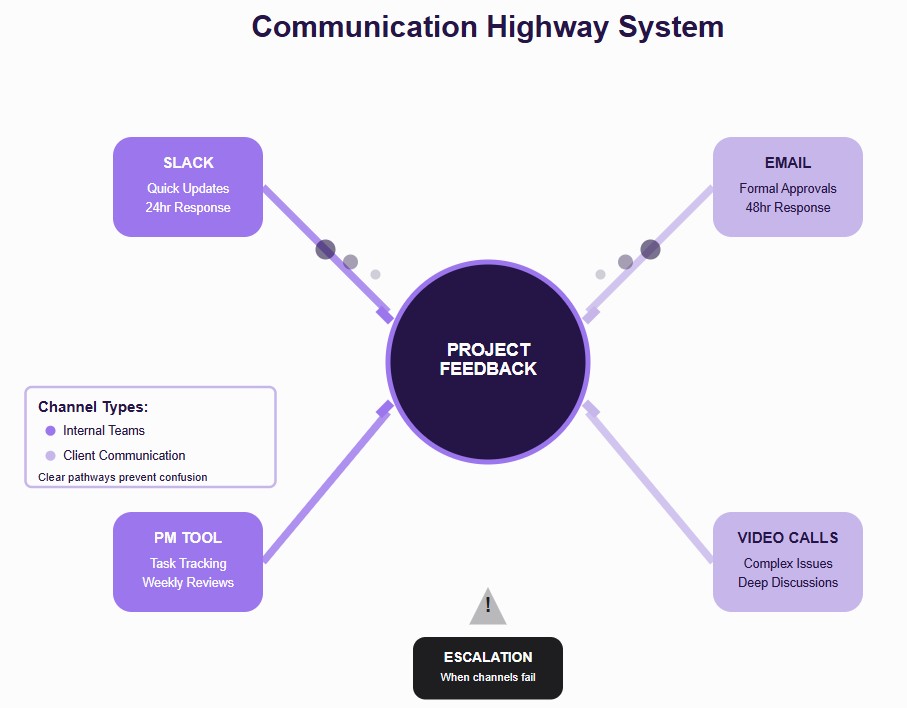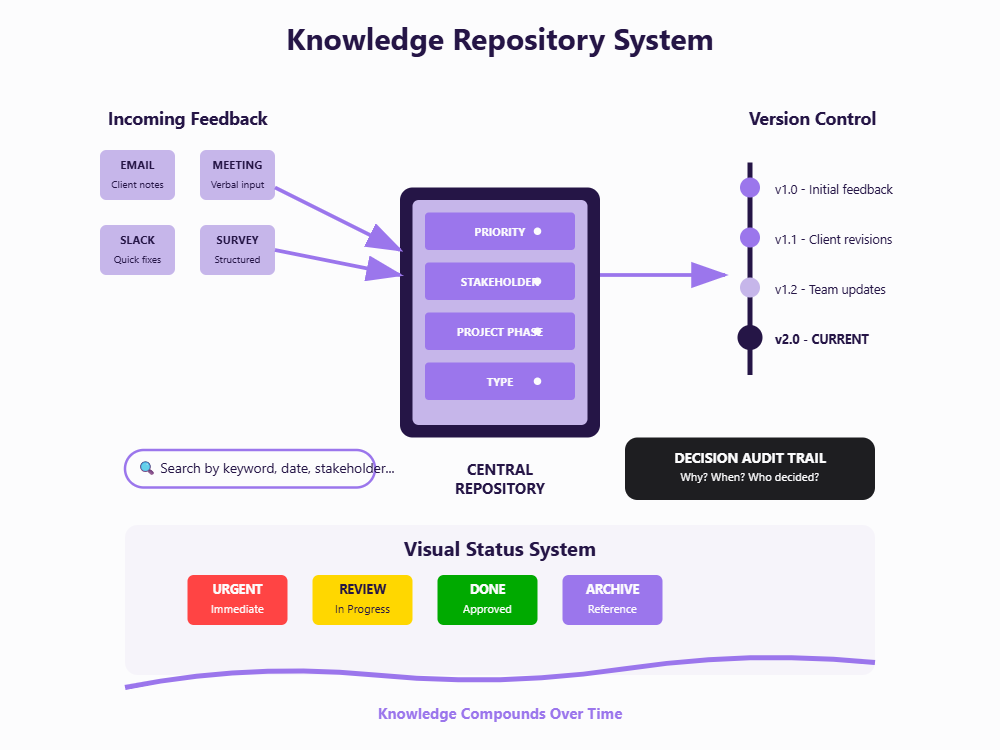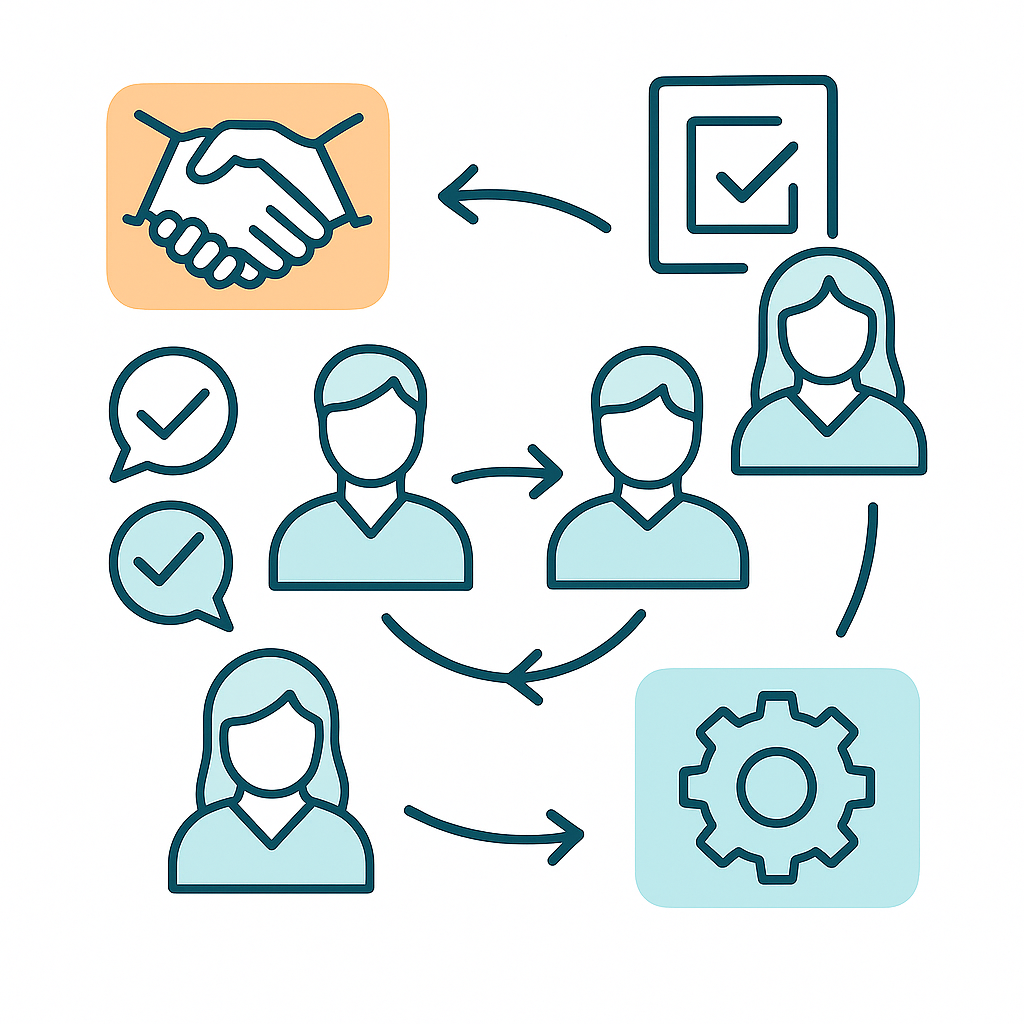Did you know the average person forgets 50% of what they hear within an hour? Now imagine running a project without a proper feedback system. It’s a recipe for misalignment, missed deadlines, and unhappy clients.
If you’ve ever felt stuck between vague comments and endless revisions, it’s time to learn how to create a feedback loop with clients and project teams that drives results.
In this article, we will:
- Make your feedback loop unstoppable with this 6-step system
- Use these ready-made templates to simplify feedback management
- Solve common feedback issues before they derail your project
Build bulletproof feedback loops: Your 6-step framework for client and team success
Creating effective feedback loops isn't just about collecting opinions; it's about building a systematic approach that transforms how your projects flow from conception to completion. When done right, feedback loops reduce project revisions and increase client satisfaction scores significantly.
Here's the proven 6-step framework that will help you build feedback loops that work:
1. Establish clear communication channels
The foundation of any successful feedback loop starts with crystal-clear communication pathways. Without designated channels, feedback gets lost in email chains, overlooked in casual conversations, or buried in lengthy meeting notes. Think of communication channels as the highways that carry your most valuable project cargo - feedback and insights.
Essential Channel Setup:
- Primary platforms: Choose 2-3 main tools (Slack for quick updates, email for formal feedback, project management tools for tracked responses)
- Response time expectations: Set clear timelines (24 hours for urgent feedback, 48 hours for standard requests, 1 week for comprehensive reviews)
- Escalation protocols: Define when and how to escalate unresolved feedback issues to senior stakeholders
- Channel-specific purposes: Designate specific channels for different types of feedback (creative reviews vs. technical issues)

Pro Tip: Create a "Communication Charter" document that outlines which channel to use for what type of feedback. Share this alongside your project charter with all stakeholders during project kickoff to prevent confusion later. For example, use Slack for quick clarifications, email for formal approvals, and your project management tool for tracked action items.
2. Define feedback touchpoints
Strategic timing is everything when it comes to collecting meaningful feedback. Random check-ins often catch people unprepared, while scheduled touchpoints ensure stakeholders come ready with thoughtful input. The secret is creating a rhythm that feels natural rather than burdensome.
Critical Touchpoint Schedule:
- Project kickoff feedback sessions: Gather initial expectations, concerns, and success criteria
- Milestone review checkpoints: Schedule feedback collection at 25%, 50%, and 75% completion marks
- Weekly progress updates: Brief status calls to catch issues before they become problems
- Post-delivery retrospectives: Comprehensive reviews to improve future project cycles
Implementation Strategy: Consider implementing milestone-based feedback collection at 25%, 50%, and 75% project completion, especially effective when paired with project management software for product development to capture input at critical design and testing phases.
This approach helps prevent major course corrections near project deadlines and keeps stakeholders engaged throughout the project lifecycle without overwhelming them with constant requests for input.
3. Create structured feedback templates
Unstructured feedback is often unhelpful feedback. When clients or team members provide vague comments like "make it pop" or "something feels off," projects stall while everyone tries to decode the real meaning. Structured templates guide stakeholders to provide actionable, specific feedback that drives results.
Template Components:
- Standardized feedback forms: Include fields for specific areas (design, functionality, messaging, timeline concerns)
- Rating scales and specific criteria: Use 1-10 scales with clear descriptors for each rating level
- Action item tracking systems: Built-in sections for assigning responsibilities and deadlines
- Priority classification: High/Medium/Low categories to help teams focus on critical issues first
Template Success Strategy: Design your feedback forms with "forced specificity"—instead of asking "What do you think?", ask "Rate the visual appeal (1-10) and explain what specific elements support or detract from the overall design goal." This approach generates 70% more actionable feedback than open-ended questions.
4. Implement regular check-in schedules
Consistency beats intensity when building effective feedback rhythms. Sporadic, lengthy feedback sessions often overwhelm participants and generate surface-level responses. Regular, shorter check-ins create momentum and keep projects moving smoothly forward.
Optimal Check-in Frequency:
- Daily standups for internal teams: 15-minute focused sessions on progress, obstacles, and immediate needs
- Weekly client status calls: 30-minute structured updates with a prepared agenda and specific questions
- Bi-weekly strategic reviews: Deeper dives into project direction, goal alignment, and major decisions
- Monthly relationship check-ins: Broader conversations about working relationships and process improvements
Meeting Efficiency Hack: Start each check-in with a "feedback temperature check"—ask participants to rate their current satisfaction level (1-10) and explain any scores below 8. This immediately surfaces issues that need attention and prevents small problems from becoming project disasters.
5. Document and track feedback
Feedback without documentation is just an expensive conversation. The most brilliant insights become worthless if they're not captured, organized, and made accessible to the right people at the right time. Smart documentation turns feedback into a strategic asset that improves every future project.
Documentation Best Practices:
- Central feedback repository: One searchable location where all feedback lives (shared drive, project management tool, or dedicated platform)
- Version control for changes: Track what changed, when, why, and who requested the modification
- Decision audit trails: Record the reasoning behind major decisions for future reference
- Feedback categorization: Tag feedback by type, priority, stakeholder, and project phase

Documentation Pro Tip: Use a simple color-coding system for feedback status: Red for "needs immediate attention," Yellow for "under review," and Green for "completed and approved." This visual system allows anyone to quickly understand project status without reading detailed notes.
6. Close the loop with follow-up actions
The most critical step in any feedback loop is closing it. Many projects fail not because they don't collect feedback, but because they don't effectively communicate what happens next. Closing the loop builds trust, demonstrates value, and encourages future participation in the feedback process.
Loop-Closing Essentials:
- Acknowledge receipt of feedback: Respond within 24 hours to confirm you've received and understood the input
- Communicate implementation plans: Explain what will be changed, what won't be changed, and why
- Confirm completion and satisfaction: Follow up after implementing changes to ensure the feedback provider is satisfied with the results
- Share broader impact: When possible, explain how individual feedback contributed to overall project success
Follow-up Template Strategy: Create a standardized follow-up email template that includes three key sections: acknowledgment of the specific feedback received, a clear explanation of actions taken or planned, and a direct question asking for confirmation. This systematic approach ensures no feedback gets overlooked and creates a paper trail that helps prevent scope creep and miscommunication down the line.
Building effective feedback loops, especially when guided by a stakeholder engagement plan, is like constructing a bridge; every element must be strong enough to support the weight of honest communication, and the entire structure must facilitate smooth two-way traffic between all stakeholders.
Start with one or two steps, master them, then gradually implement the complete framework for maximum impact.
Copy-paste templates that transform your feedback process
The difference between successful feedback loops and chaotic communication often comes down to having the right templates ready when you need them. Instead of crafting emails from scratch or fumbling through unstructured meetings, these proven templates give you a professional framework that clients and teams respond to.
Client feedback request email template
Subject Line: [Project Name] - Your Feedback Needed by [Date]
Hi [Client Name],
We've reached the [milestone/phase] stage of your project, and your input is crucial for our next steps.
What we need from you:
- Review the attached [deliverable/document/design]
- Rate your satisfaction (1-10) for each section
- Highlight any areas that need adjustment
- Confirm if we're aligned with your vision
Please provide feedback by [specific date] so we can maintain our project timeline.
Questions to guide your review:
- Does this meet your initial expectations?
- What specific changes would improve this deliverable?
- Are there any concerns we should address immediately?
Reply directly to this email or schedule a 15-minute call if you prefer to discuss.
Best regards, [Your Name]
Communication charter template
Project: [Project Name]
Effective Date: [Start Date]
Communication Channels & Purposes
- Slack/Teams: Quick questions and daily updates
- Email: Formal approvals and documented decisions
- Project Management Tool: Task updates and milestone tracking
- Video Calls: Complex discussions and weekly check-ins
Response Time Expectations
- Urgent issues: 4 hours
- Standard requests: 24 hours
- Comprehensive reviews: 48-72 hours
Escalation Path
If responses are delayed beyond agreed-upon timeframes:
- First escalation: Direct message to the project lead
- Second escalation: Email to department manager
- Final escalation: Call scheduled within 24 hours
Weekly feedback meeting agenda
Meeting Duration: 30 minutes
Attendees: [List key stakeholders]
Agenda Structure (5 minutes each section)
- Progress Update: What was completed this week
- Feedback Review: Address submitted feedback from last meeting
- Current Deliverables: Present work ready for review
- Roadblocks Discussion: Identify and resolve obstacles
- Next Week Priorities: Confirm upcoming milestones
- Action Items: Document next steps with owners and deadlines
Meeting Rules
- Come prepared with specific feedback, not general impressions
- Decisions made in this meeting are final unless new information emerges
- Action items are documented and shared within 2 hours
Feedback tracking & closure template
Feedback Item #: [Unique ID]
Date Received: [Date]
Source: [Client/Team Member Name]
Priority Level: High/Medium/Low
Feedback Details
Original Feedback: [Exact feedback received]
Interpretation: [What action is required]
Assigned To: [Team member responsible]
Target Completion: [Date]
Resolution Process
- Acknowledged: ✅ [Date/Time]
- In Progress: ✅ [Date started]
- Completed: ✅ [Date finished]
- Client Confirmation: ✅ [Date confirmed]
Follow-up Actions
Email sent to feedback provider: [Date]
Changes documented: [Location/link]
Stakeholders notified: [Date and method]
These templates work because they eliminate guesswork, set clear expectations, and create accountability for everyone involved in your feedback process.
Feedback loop challenges (and how to fix them fast)
Even the most well-structured feedback loop can hit roadblocks. From ghosting clients to vague one-liners like “it doesn’t feel right,” these friction points can derail timelines and team morale.
Let’s explore some real-world feedback loop challenges and how to solve them before they spiral.

The vanishing client: Unresponsive stakeholders
The Problem: You've sent three follow-up emails, left voicemails, and your project timeline is slipping because key stakeholders have gone radio silent. Deadlines are approaching, but you can't move forward without their input, and every day of delay compounds the problem.
Quick-Fix Solutions:
- Change your communication channel: If email isn't working, try calling directly or reaching out via their preferred platform (LinkedIn, text, or through an assistant)
- Create urgency with consequences: "Without feedback by [date], we'll proceed with Option A, which may require additional revisions later."
- Simplify the ask: Break complex requests into 3-5 yes/no questions instead of open-ended reviews
- Offer phone alternatives: "I can explain this in a 10-minute call if reviewing documents isn't convenient."
- Set up automatic escalation: Have predetermined contacts who can provide feedback when primary stakeholders are unavailable
The committee chaos: Contradictory feedback from multiple stakeholders
The Problem: Marketing wants the design "bolder and more vibrant," while the CEO demands "clean and professional." Legal requires compliance changes that conflict with user experience recommendations. Everyone thinks their feedback is most important, and you're stuck in the middle trying to please everyone while pleasing no one.
Conflict Resolution Strategy:
- Establish stakeholder hierarchy: Document who has final decision-making authority for different project aspects
- Schedule alignment meetings: Get conflicting parties in the same room (virtual or physical) to hash out differences directly
- Create decision matrices: Use weighted scoring to objectively evaluate conflicting suggestions based on project goals
- Propose compromise solutions: Present 2-3 options that blend conflicting feedback rather than choosing sides
- Document all decisions: Record the reasoning behind choices to prevent rehashing settled issues
The emotional minefield: Vague or emotionally charged comments
The Problem: "This just doesn't feel right," "It needs more pizzazz," or "I hate everything about this!" are the extent of the feedback you're receiving. Emotional reactions replace constructive criticism, leaving your team guessing what needs to change while dealing with frustrated or upset stakeholders.
Defusing and Clarifying Tactics:
- Acknowledge emotions first: "I can see this isn't meeting your expectations. Let's figure out exactly what needs to change."
- Ask specific follow-up questions: "What specifically feels wrong?" or "Can you point to an example of what you'd prefer?"
- Use the "scale and explain" method: "Rate this 1-10 and tell me what would make it a 9 or 10."
- Schedule face-to-face time: Emotional feedback often resolves better in real-time conversation than written exchanges
- Provide structured feedback forms: Guide emotional responders with specific categories and rating scales
The internal tug-of-war: Team misalignment on feedback priorities
The Problem: Your design team thinks the client's color feedback is crucial, while developers insist the functionality issues should be addressed first. Internal disagreements about which feedback to prioritize create delays and frustration, with team members working on different priorities instead of collaborating effectively.
Priority Alignment Solutions:
- Create feedback triage meetings: Gather key team members to jointly evaluate and rank all feedback by impact and effort
- Use the MoSCoW method: Categorize feedback as Must-have, Should-have, Could-have, or Won't-have this iteration
- Assign feedback ownership: Designate specific team members responsible for different types of feedback (technical, creative, strategic)
- Implement voting systems: Let team members vote on priority when consensus isn't immediate
- Set regular priority review cycles: Schedule weekly 15-minute sessions to reassess and realign priorities
Feedback loops break down not because of too much feedback, but because of unclear expectations, poor processes, or a lack of alignment. Tackle these challenges head-on, and your feedback loop becomes a growth engine, not a bottleneck.
Create feedback rituals that scale with your team
Building a feedback loop isn’t a one-time fix; it’s a habit. By setting clear channels, structured touchpoints, and consistent follow-through, you create a system that scales with your team and strengthens every client relationship.
Use the templates, tools, and strategies shared in this guide to turn feedback into your team’s most reliable growth engine. Start small, stay consistent, and watch your projects run smoother, faster, and with fewer surprises.



_light%201.png)





